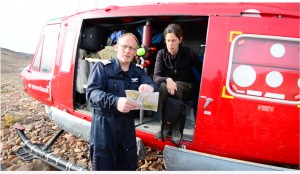Increasing numbers of scientists and graduate students are posting videos that show various aspects of their research—in the laboratory and the field. Such videos serve many purposes, both for the researcher and for society. Take a look at this example and then we’ll talk about the benefits of making such a video.
Videos that depict scientists and students doing their research can have multiple benefits—both for the individual researcher, as well as for society.
1. Raise visibility. Early career scientists struggle to make a name for themselves in their chosen field. The traditional approach is to publish in journals and to present at science conferences. Those forms of formal communication of science are still important, but now there are additional tools that scientists can use to share their work: social media, science blogs, and videos. The video example above highlights the dissertation research of a Ph.D. student at Charles Darwin University, Mike Miloshis, who is studying how sea-level rise is changing the wetlands along the Mary River. Well-done videos like this can be used by the student or by the student’s department or university to more easily share their work with prospective employers or funders, policy-makers, the media, and the general public.
Only a handful of people will likely read your dissertation, but many more will be willing to watch a video showing what you did, how you did it, and why it’s important.
2. Solicit funding. Video is an excellent way to explain your research to prospective funders—particularly people without a science background. Crowd-funding platforms are springing up that require investigators to submit their research proposal in the form of a brief video. Members of the scientific community and the general public watch the videos and pledge a donation or vote for those projects they wish to support. One example is Thinkable, which just awarded $5,000 (AUD) to an Australian cancer researcher and is about to award almost $15,000 (AUD) in another competition based on submitted 3-minute videos.
Those students and established scientists with video skills are at a clear advantage in such competitions.
3. Augment a CV or resume´. Video is an effective and efficient way to share information about a researcher’s unique interests, skills, and accomplishments. A video can paint a picture that is more distinctive and memorable than a written description in a resume´ or on a website. In a few short minutes, the video above showed this researcher’s general knowledge of his topic and ability to communicate it, as well as his expertise with various types of scientific equipment. Because it’s visual, video makes that information more memorable. It’s especially effective at getting across intangible qualities such as enthusiasm, confidence, energy, creativity, eloquence, and humor.
See this post for more information about making a video resume´.
4. Recruit students. A video can not only solidify a distinctive image for a researcher, it can serve as a great recruiting tool for an academic looking to attract students or post-docs. The video above depicts what it’s like to do river research and explains why the topic is important to study without getting too bogged down in scientific details. In a broader sense, such videos can show other students what graduate research is like in a particular field and what some of the challenges are.
By encouraging students to make videos about their experiences, schools can attract prospective students and help them anticipate what they will face in graduate school.
5. Inform the public. In addition to benefits for the individual researcher, videos can simultaneously inform the public about the importance of a research topic and the nature of scientific research. The average person is curious about science but may view it as a mysterious process conducted behind closed doors by socially awkward, introverted, cold, mad, obsessive, [insert your stereotype] people. Many envision a lab-coated, old guy toiling away in a laboratory.
Videos like the above example show that research is carried out in all kinds of environments and by perfectly normal people. In other words, videos can help put a human face on science.
How do you create a video to portray your dissertation research? You have a couple of options: join forces with a videographer or do it yourself. The video example I’ve highlighted in this post was a joint production between the graduate student and a videographer friend. If you are studying at a university, try approaching someone with multimedia skills.
If that doesn’t work out, you can make the video by yourself or perhaps with the help of a fellow student or your advisor. Making videos is now quite easy with mobile devices that shoot HD video and simple-to-use yet powerful movie editing software. A smartphone is truly all you need these days to create a professional and effective video to share your unique qualities with others.


